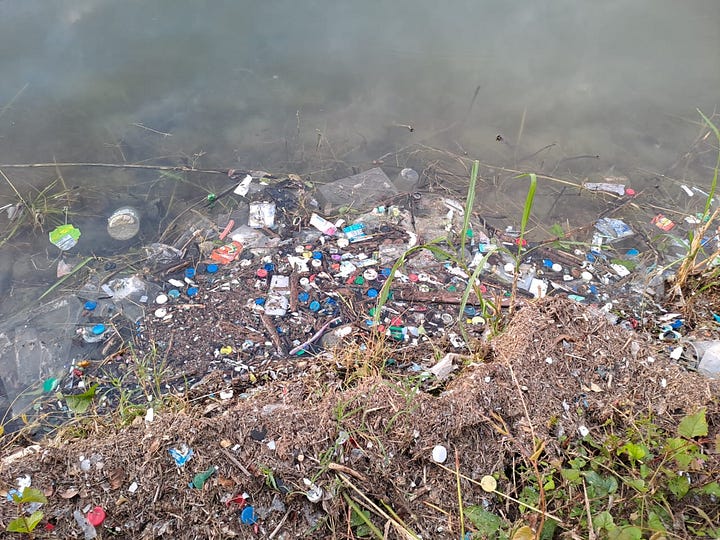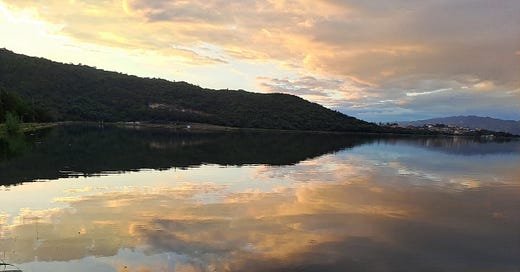On Christmas Eve, I went for my usual weekend walk at the Mona Reservoir. I started going there in 1980 – gosh, 43 years ago – and in those days I ran mostly two laps (3.4 miles, if memory serves and/or was the right calculation in the first place) and sometimes what we used to call a Big C. Half on the road around the dam, half on a track around the base in the shade of big shade trees. In the years when I was going to the University of the West Indies as a part-time Management Studies evening student, I went early in the morning and saw the sunrise. Other years I went in the afternoons – there was less traffic in Kingston then, so there was no problem getting there. It was not free, but the membership fee was modest and the biggest hurdle was the procurement of an ID card, which was hardly ever checked.
The Mona Reservoir is one of two freshwater dams which serve the city of Kingston. It was built in the late 1940s and commissioned in the 1950s and is filled by a tributary of the Hope River, flowing out of the Blue Mountains and more recently by a pipeline from the Yallahs River.
What I like best about Mona Dam is the view of the Blue Mountains – the low hills rising from the Liguanea Plain, especially in the wet months, when they are green and you can imagine they are still thickly forested, the darker, higher mountains majestic behind them. It’s really a place to lift your eyes to the hills and forget day-to-day annoyances. I also love the trees on the National Water Commission site where the reservoir sits – the guangos, the woman tongue trees which rattle their pods in the dry time, the poincianas. The birds – Old Joes (pelicans, for non Jamaicans) hunting for fish, the divers (pied-billed grebes), the various herons. My favourite are the divers, small waterbirds, which seem to operate in pairs and in the breeding season build rafts for nests. If you take the time to look, you can see them constructing these rafts, mooring them to grasses and reeds at the water’s edge, but the eggs when laid are so visible, I wonder how any survive to hatching. Plus the water levels rise and fall quickly, sometimes you see the rafts detached and floating away. But the birds defend them, chasing away bigger birds, pulling a V-shaped trail behind them through the water.
I’ve seen the Mona Dam overflowing as it is now, and I’ve seen it so depleted that a small, silty island emerged in the centre and a paw paw (papaya) tree grew. That’s what my memory serves up anyway, could have been any shrub. I’ve seen a cow standing on the steep, cobbled slopes of the dam, mooing its distress – I did not witness its removal and prefer not to think about what might have happened. There was the time some chlorine tanks exploded and joggers fainted, and the other time when there was a massive fish kill – a turnover, the scientists called it – and the dam was carpeted with dead and dying tilapia. In the 1990s plastic joined the silted flow of the early Hope River intake, and now there is nearly always a scrim of bottles, caps and plastic bags clinging to the edges. Now there are floating solar panels, presumably providing power to the nearby water treatment plant, a sign encouraging everyone to exercise for 30 minutes a day, concrete benches for push ups and sit ups (those are not new), a drinking water station which I’ve never seen used by anyone – I’m not even sure it works. The fee has gone up. And there has been crime, hold ups and threats, and over the years, the number of security guards has increased, fences have been rebuilt or strengthened. Sometimes, when I walk alone these days – no more running – I play over in my mind how quickly I could jump into the dam if threatened, since I am still a strong swimmer.
On Christmas Eve 2023, I took three pictures – a bloated, dead dog close to the Hope intake, which I learned no one had yet reported, the ubiquitous floating garbage and the beauty of the reflected sky in the water.


These images spoke directly to me about Jamaica – its enduring beauty, the growing risks of living here, and our own relentless lack of care. I reported the dog, already writing this piece in my mind, wondering if publicizing what I saw might get my pass cancelled. Driving home I thought about what it means to cleave to a place, and somehow, Mona Dam means that to me – a place I’ve known for more than half my life, where I greet and am greeted by others - strangers, public figures, old friends – a place where I’ve gathered memories – I reconnected with my husband there - and a place which still delivers awe and gratitude at the sight of the Blue Mountains.
Wishing all my readers a peaceful and healthy 2024 – thank you for subscribing and spending a little time with me.





I remember walking there in days gone by. We would all hang out and lime by this low wall where I would stretch my young hamstrings. It is a real treasure I do hope Kingstonians recognize that.
Wow!! I had no idea there was so much birding to be done there! Thank you. I feel the same way about the line of mystic Blue Mountains that I watch practically all day from my balcony, and especially the sight of the sunrise progressing from north to south and back between the solstices. I guess that as long as some of us hold on to the memory of perfection and care enough to speak up when we see something wrong, we may still inspire enough people to care and make the difference. Thank you.